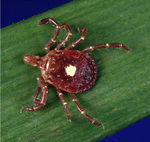Difference between revisions of "Amblyomma spp."
| (One intermediate revision by one other user not shown) | |||
| Line 1: | Line 1: | ||
| − | {{ | + | {{OpenPagesTop}} |
| − | |||
{{Taxobox | {{Taxobox | ||
|name =''Amblyomma spp.'' | |name =''Amblyomma spp.'' | ||
| Line 39: | Line 38: | ||
Found throughout Africa, this tick is very important in its ability to transmit ''Cowdria ruminatium'' ([[Heartwater|heartwater]]) in Africa as well as viral Nairobi sheep disease and [[Q Fever]]. There is distinct variation in the appearance of the males and female, the males are highly ornate with orange markings on the scutum compared to the brown female with a large pale patch on the scutum. | Found throughout Africa, this tick is very important in its ability to transmit ''Cowdria ruminatium'' ([[Heartwater|heartwater]]) in Africa as well as viral Nairobi sheep disease and [[Q Fever]]. There is distinct variation in the appearance of the males and female, the males are highly ornate with orange markings on the scutum compared to the brown female with a large pale patch on the scutum. | ||
| − | + | {{Learning | |
| − | + | |literature search = | |
| − | |||
| − | |||
| − | |||
| − | |||
[http://www.cabdirect.org/search.html?rowId=1&options1=AND&q1=title%3A%28%22Amblyomma%22%29&occuring1=freetext&rowId=2&options2=AND&q2=&occuring2=freetext&rowId=3&options3=AND&q3=&occuring3=freetext&publishedstart=2000&publishedend=yyyy&calendarInput=yyyy-mm-dd&la=any&it=any&show=all&x=66&y=15 ''Amblyoma'' spp. publications since 2000] | [http://www.cabdirect.org/search.html?rowId=1&options1=AND&q1=title%3A%28%22Amblyomma%22%29&occuring1=freetext&rowId=2&options2=AND&q2=&occuring2=freetext&rowId=3&options3=AND&q3=&occuring3=freetext&publishedstart=2000&publishedend=yyyy&calendarInput=yyyy-mm-dd&la=any&it=any&show=all&x=66&y=15 ''Amblyoma'' spp. publications since 2000] | ||
| Line 50: | Line 45: | ||
[http://www.cabdirect.org/search.html?q=title%3A%28%22Amblyomma+variegatum%22%29 ''Amblyomma variegatum'' publications] | [http://www.cabdirect.org/search.html?q=title%3A%28%22Amblyomma+variegatum%22%29 ''Amblyomma variegatum'' publications] | ||
| + | |||
| + | |Vetstream = [https://www.vetstream.com/canis/search?s=tick Tick] | ||
| + | }} | ||
==References== | ==References== | ||
* http://www.cfsph.iastate.edu/Factsheets/pdfs/boophilus_microplus.pdf | * http://www.cfsph.iastate.edu/Factsheets/pdfs/boophilus_microplus.pdf | ||
| + | {{review}} | ||
| + | |||
| + | {{OpenPages}} | ||
[[Category:Hard Ticks - Overseas]] | [[Category:Hard Ticks - Overseas]] | ||
[[Category:Expert_Review]] | [[Category:Expert_Review]] | ||
Latest revision as of 17:23, 4 June 2016
| Amblyomma spp. | |
|---|---|
| Kingdom | Animalia |
| Phylum | Arthropoda |
| Class | Arachnida |
| Sub-class | Acari |
| Super-order | Parasitiformes |
| Order | Ixodida |
| Super-family | Ixodoidea |
| Family | Ixodidae |
| Genus | Amblyomma |
| Species | A. americanum, A. variegatum |
These ticks can be identified by;
- Large size
- Ornate scutums
- Eyes present
- Festoons
- Long palps
- Long legs
These ticks are distributed throughout tropical and sub-tropical areas of Africa as well as in temperate North America. The large mouth parts cause large painful bites and allow the females to ingest large volumes of blood which can lead to anaemia.
Amblyomma americanum
Also known as: Lone star tick
This tick is found throughout central and eastern USA and is primarily important as a vector but has also been shown to reduce weight gain in cattle. It is responsible for transmission of Rickettsia rickettsii, Francisella tularensis, Q Fever and Berrelia burgdorferi
Amblyomma variegatum
Also known as: Bont ticks — Variegated or tropical bont tick
Found throughout Africa, this tick is very important in its ability to transmit Cowdria ruminatium (heartwater) in Africa as well as viral Nairobi sheep disease and Q Fever. There is distinct variation in the appearance of the males and female, the males are highly ornate with orange markings on the scutum compared to the brown female with a large pale patch on the scutum.
| Amblyomma spp. Learning Resources | |
|---|---|
To reach the Vetstream content, please select |
Canis, Felis, Lapis or Equis |
 Search for recent publications via CAB Abstract (CABI log in required) |
Amblyoma spp. publications since 2000 |
References
| This article has been peer reviewed but is awaiting expert review. If you would like to help with this, please see more information about expert reviewing. |
Error in widget FBRecommend: unable to write file /var/www/wikivet.net/extensions/Widgets/compiled_templates/wrt66868ceebe4c97_17814161 Error in widget google+: unable to write file /var/www/wikivet.net/extensions/Widgets/compiled_templates/wrt66868ceec462f9_80385109 Error in widget TwitterTweet: unable to write file /var/www/wikivet.net/extensions/Widgets/compiled_templates/wrt66868ceec97222_93477127
|
| WikiVet® Introduction - Help WikiVet - Report a Problem |
